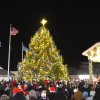Arctic conditions pushing rare snowy owls into Delaware
From Port Penn in New Castle County to Delaware Seashore State Park in Sussex, Delawareans are enjoying a rare and unprecedented spectacle: the sudden appearance of snowy owls throughout the state.
Why here and why now for the snowy owls? Because it seems Delaware offers a good prey menu this year, which the snowy owls may not have had in their harsh Arctic habits. As an apex predator atop the food chain in the far northern range of the continent, a snowy owl over a year ordinarily consumes hundreds of small rodents called lemmings. But lemming populations in the Arctic are cyclical, rising and falling as results of population size, habitat conditions, and their own food availability. When lemming populations fluctuate, the owls irrupt - or disperse widely - to find food that’s sometimes well outside of their normal range.
An irruption may also occur when high lemming populations enable snowy owls to produce large broods that are unsupportable by local habitat as the owlets mature. In either event, the winter of 2013-2014 finds snowy owls from the far north dispersing well beyond their normal range.
Snowy owls in Delaware are not unheard of, according to DNREC Division of Fish & Wildlife Biologist Anthony Gonzon: “In any given year, one or two owls may show up throughout the course of the entire winter. For example, a single snowy owl was observed in late 2012 near Rehoboth Beach, but it remained here only for a short time.
“This year, however, is quickly shaping up to be extraordinary and unprecedented,” Gonzon said. “Over the course of six days surrounding Thanksgiving, at least six snowy owls have been sighted, providing Delawareans a great opportunity to share in this phenomenon.”
In particular, the owls seen along Delaware Seashore State Park have remained in the same general area since being first observed on Friday, Nov. 29, providing hundreds of visitors from Delaware, Maryland, Virginia, Pennsylvania, and New Jersey many opportunities to see and photograph them. Snowy owls have also been spotted along Route 9 near Port Penn, Bombay Hook National Wildlife Refuge near Smyrna, Port Mahon Road near Little Creek, and Cape Henlopen State Park.
Snowy owls are big birds weighing as much as 6.5 pounds with wing spans up to five feet. They range from nearly all white (adult males) to white with many dark bars across the forehead, breast and belly (juvenile female), and have a distinctive black beak. Adult females and juvenile males fall somewhere in between. Male owls are smaller than the females, but this might be difficult to determine without a good comparison.
Arriving from the Arctic ends a long journey to find food for these owls. They are most likely to show up near the largest expanses of open habitat in Delaware, starting first along the Delaware bayshore marshes and dunes, and also touching down in the dunes along the ocean beaches. “Over the next few weeks, we might expect the birds to show up farther inland, especially in areas of larger, open agriculture fields, looking for rodents,” Gonzon said. Snowy owls are well adapted to hunt both day and night and can be active throughout the entire day, so it would not be unusual to find one flying about at high noon, unlike the more nocturnal owl species.
Here are some viewing tips for those who want to find and observe snowy owls:
• Sites along the Delaware bayshore and ocean coast provide the best chances for encountering a snowy owl. Look for white spots on the dunes, in the marshes, or in large fields, often on elevated mounds or structures.
• Upon locating an owl, keep your distance. Remember that these are wild creatures from a region where people are few and far between.
• Please do not disturb or flush a snowy owl. They are already stressed from their long journey, and need to be focused on energy conservation and foraging.
• Please practice good conservation and bird-watching ethics. Always keep the best interests of the owl and other observers first. Remember that you are not the only one who wants to experience these rare raptors. Your desire to get a closer look or better photo could easily ruin the same opportunity for others.
• Please do not feed or attempt to feed the snowy owls. Snowy owls are very well equipped to find food on their own.
• Please respect private property when bird-watching and also be respectful of other limited access areas. Enjoy the snowy owls from a safe, permissible location both for yourself and others.
Editor's Note: This is a press release from Delaware's Department of Natural Resources and Environmental Control.






















































